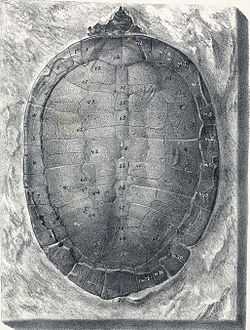Pleurosternon
| Pleurosternon Temporal range: 161.2–99.6Ma Late Jurassic-Early Cretaceous | |
|---|---|
 | |
| Pleurosternon (ovatum) bullocki fossil | |
| Scientific classification | |
| Kingdom: | Animalia |
| Phylum: | Chordata |
| Class: | Sauropsida |
| Order: | Testudines |
| Suborder: | Cryptodira |
| Family: | Pleurosternidae |
| Genus: | Pleurosternon Owen, 1853 |
| Species | |
| |
| Synonyms | |
| |
Pleurosternon is an extinct genus of cryptodire turtle from the late Jurassic period to the early Cretaceous period.[1] Its type species, P. bullocki was described by the paleontologist Richard Owen (noted for coining the word Dinosauria) in 1853. Since then, and throughout the late 19th century, many fossil turtles were incorrectly assigned to this genus.
Taxonony
Pleurosternon fossils were first described by Richard Owen in 1841 under the living genus Platemys.[2] It was not until 1853 however, that it was published under the name Pleurosternon in a paper Owen presented to the Palaeontographical Society.[3]
Phylogeny
Cladogram after Tyler R. Lyson and Walter G. Joyce (2009).[4]
| |
| ||||||||||||||||||||||||||||||||||||||||||||||||||||||||||||||||||||||||||||||||||||||||||||||||||||||
| |
Description

Pleurosternon has a very depressed carapace, much flatter than similar genera, such as the North American Late Jurassic and Early Cretaceous Glyptops.[5][6] Adults show little or none of the nuchal emargination that is more visible in juveniles.[6] The Xiphiplastras also have a large, V-shaped notch near the back of the bone.[6] Together with Platychelys, it is one of the few turtle genera to exhibit the characteristics of both modern turtle suborders, the Cryptodira and the Pleurodira.[7]
Distribution and habitat
In Europe, most species of Pleurosternon are best known from southeast England's Purbeck Group and Portland stone, some specimens were even recovered in the Purbeck's type locality.[8][9] Several areas within the formation became noted by some for producing pleurosternon fossils. Among them were Swanage, Durlston Bay, Langton Matravers, and Herston.[10]
The genus has also been found in several rock formations from the upper Jurassic in both France and Spain,[11] and from the Cretaceous Wealden group of both England and northern Germany.[12] The Purbeck formation, at the time was a coastal region with a complex system of shallow lagoons that slowly lost their salinity over time.[13] Similarly, the younger Wealden group was also coastal plain dominated by lagoons but with the addition of braided streams.[14] The Portland stone, however is a maritime deposit of similar age near the Purbeck, most bones found there are interpreted as having washed out to sea from the Wealden or the Purbeck. Because of this, Pleurosternon has been described as a "shore-turtle".[5]
See also
- Glyptops
- Chengyuchelys
- Helochelys
References
- ↑ E. Schweizerbart. 1994. Neues Jahrbuch für Geologie und Paläontologie: Monatshefte, Issues 7-12.
- ↑ Owen, Richard. Report on British Fossil Reptilia. Report of the British Association for the Advancement of Science. P. p43- 126. 1841
- ↑ Owen, R. A Monograph of the Fossil Chelonian Reptiles of the Wealden Clays and Purbeck Limestones. Palaeontographical Society, Vol. VII, 1853
- ↑ Tyler R. Lyson and Walter G. Joyce (2009). "A Revision of Plesiobaena (Testudines: Baenidae) and an Assessment of Baenid Ecology Across the K/T Boundary". Journal of Paleontology 83 (6): 833–853. doi:10.1666/09-035.1.
- ↑ 5.0 5.1 Boule, Marcellin. Priviteau, Jean. Les Fossiles. Éléments De Paléontologie. Libraries de L'académie Médecine. Paris, 1935. P. 433
- ↑ 6.0 6.1 6.2 Milner, Andrew R. 2004. The Turtles of the Purbeck Limestone of Dorset, Southern England. Palaeontology. Vol. 47. part 6. pp. 1446-1447
- ↑ Neaverson, E. 1955. Stratigraphical Palaeontology: a Study of Ancient Life-Provences. Second Edition. Oxford. Clarendon Press. p.114
- ↑ Hay, Oliver Perry. 1908. Fossil Turtles of North America. Carnegie Institution of Washington. p. 45
- ↑ Neaverson, 466
- ↑ Milner, 1448
- ↑ A. PÉREZ GARCÍA,, F ORTEGA & F ESCASO. A small pleurosternid turtle from the Upper Jurassic of Santa Rita (Torres Vedras, Portugal): Juvenile or new form? 7th Annual EAVP Meeting 2009. 56
- ↑ Abel, Othenio. 1919. Die Stämme der Wirbeltlere. Verinigung Wissenschaftlicher Verleger. Berlin und Leipzig. p.412
- ↑ Radley, Jonathan D. Distribution and Environmental Significance of Molluscs in the Late Jurassic-Early Cretaceous Purbeck Formation of Dorset, Southern England: a Review. Life and Environments in Purbeck Times. (Special Papers in Palaeontology No. 68). p 48.
- ↑ Jackson, A.A.; 2008: Bedrock geology UK south. An explanation of the bedrock geology map of England and Wales - 1:625,000 edition, Keyworth, Nottingham, British Geological Survey, ISBN 978-0-85272-586-3.